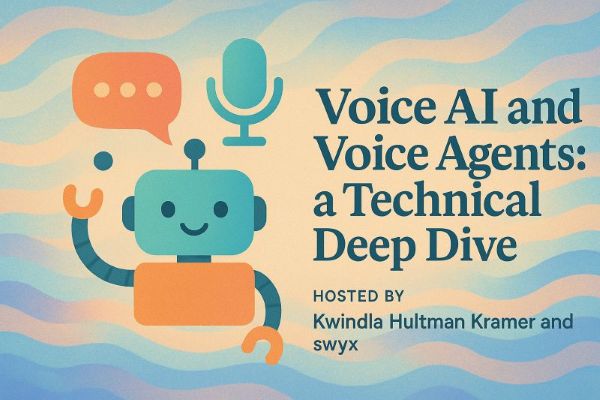[GroupBuy] Voice AI and Voice Agents – A Technical Deep Dive
$59.00
Discount 20% if your total cart over $150
- Satisfaction Guaranteed
- Fast and forever download link
- Secure Payments
- Reupload FREE
Description
This article delves into the exciting world of Voice AI and Voice Agents, exploring the technical intricacies and practical applications of this rapidly evolving technology. We’ll examine the key components, challenges, and opportunities within this dynamic field.
Voice AI and Voice Agents
The convergence of artificial intelligence and voice technology has unleashed a new era of human-computer interaction. Voice AI systems, powered by sophisticated algorithms and machine learning, enable computers to understand, interpret, and respond to human speech. This capability is manifested in the development of Voice Agents, also known as virtual assistants, conversational AI, or voicebots.
These agents are transforming how we interact with technology, offering seamless and intuitive experiences across diverse applications. They are no longer simple voice recognition systems; rather, they represent a sophisticated blend of natural language processing (NLP), speech synthesis, and machine learning, enabling increasingly complex and nuanced interactions. The potential applications are vast, impacting industries from customer service and healthcare to entertainment and education. This exploration will dissect the core components and challenges of building these sophisticated systems.
Understanding the Core Components of Voice AI
The development of effective Voice AI hinges on seamlessly integrating several critical components. These include advanced speech recognition systems capable of accurately transcribing human speech, regardless of accent or background noise. This accuracy is paramount; even small errors can lead to significant misunderstandings or failures in the agent’s response.
Following transcription, natural language understanding (NLU) algorithms dissect the meaning and intent behind the user’s utterance, a complex process involving parsing syntax, resolving ambiguities, and identifying entities and relationships within the text. This component often leverages machine learning models trained on vast datasets of conversations, enabling improved accuracy and adaptability over time.
Finally, for a complete Voice AI system, we need natural language generation (NLG). This component translates the interpreted meaning back into coherent and natural-sounding human language. This again requires sophisticated algorithms capable of producing grammatically correct and contextually relevant responses. The integration of these three components is crucial, forming a tightly coupled system where each component’s output feeds into the next, shaping the overall user experience.
The Challenges in Building Robust Voice Agents
Building robust and reliable Voice Agents presents several significant challenges. A major hurdle lies in the inherent variability and complexity of human language. Accents, dialects, background noise, and even individual speaking styles can significantly impact the accuracy of speech recognition. Ambiguity in language, such as sarcasm or figurative speech, further complicates the NLU process. These challenges require the deployment of sophisticated algorithms and extensive training data to ensure reliable performance, particularly in real-world scenarios where noise and variability are inevitable.
Another key area of difficulty lies in managing context in long and complex conversations. Maintaining coherence across multiple turns of dialogue while keeping track of previous interactions demands sophisticated memory models and context management paradigms. In addition, handling unexpected user input or incomplete requests requires adaptive and resilient systems capable of gracefully handling unusual contexts. Finally, ensuring user privacy and data security is also critical; the processing of personal information demands rigorous adherence to ethical guidelines and data protection regulations.
Exploring Advanced Features and Applications of Voice Agents
Beyond the fundamentals, significant advancements are pushing the boundaries of Voice AI. The integration of retrieval augmented generation (RAG) enables agents to access and process external knowledge sources, significantly expanding their capabilities and access to information. This allows them to handle a wider range of queries and provide more informed and comprehensive responses. Similarly, sophisticated conversation memory features enhance context awareness by retaining previous interactions, resulting in more personalized and natural conversations.
The integration of function calling allows Voice Agents to interact with external systems and services in real-time. This enables them to perform tasks like scheduling appointments, making reservations, or accessing information from databases, providing users with a hands-free and efficient experience. These function calls are not limited to simple interactions; they are sophisticated enough to manage asynchronous tasks—meaning the system can launch an operation and subsequently return to the conversation. Similarly, parallel and composite function calls allow for more complex, concurrent operations, providing added efficiency and speed. This technological sophistication brings a level of interaction previously confined to science fiction stories.
A Technical Deep Dive
This section will explore the technical underpinnings of Voice AI and Voice Agents, focusing on the core technologies and architectural considerations that define these systems. This is a Technical Deep Dive for those interested in the technical architecture behind making a robust and reliable Voice Agent. The course mentioned earlier provides a practical, hands-on understanding of these very concepts.
Architecting a Voice Agent System
Building a functional Voice Agent necessitates a well-defined architecture comprising several interconnected components. The foundation is the speech recognition engine, responsible for converting audio input into text. This often involves using deep learning models trained on extensive speech datasets; choices here significantly impact accuracy and efficiency. Next in the pipeline is the NLU module, which extracts intent, entities, and context from the transcribed audio. This module commonly employs techniques like dependency parsing and named entity recognition. The response generation component complements this by synthesizing the output from the NLU module into a coherent and relevant response.
Then comes the deployment and integration. Choosing the correct cloud infrastructure is important for scalability and accessibility. You must also select the correct audio codecs for optimal audio quality and bandwidth. Finally, you need to thoroughly test the entire system, focusing on various aspects, including speech recognition accuracy, NLU precision, response quality, and overall performance. Through rigorous testing you can assure a robust and efficient system.
Optimizing Performance for Real-time Interactions
Real-time interaction is a critical aspect of Voice AI systems. Latency—the delay experienced between user input and system response—has a direct impact on user satisfaction. Minimizing latency necessitates careful optimization of all system components, from speech recognition to response generation.
One key strategy is to leverage efficient algorithms and hardware acceleration, such as GPUs or specialized AI accelerators. Another important factor is the choice of network infrastructure, with low-latency connections being essential for real-time performance. This includes selection of appropriate network protocols and topologies. This ensures that data flows efficiently and effectively. In addition, careful code optimization minimizes computing overhead, thereby reducing latency. All the above ensures a near real-time experience.
Managing Context and Conversation State
Managing context is paramount, especially for tasks involving continued dialogue over sustained periods of time. Techniques like dialogue state tracking (DST) play a crucial role in maintaining continuity across the conversation. This requires sophisticated algorithms capable of tracking changes in context over time, storing relevant entities, and correctly identifying shifts in the subject matter. Maintaining state across multiple turns of dialogue is challenging yet essential for coherent and natural interactions. The complexities in design are considerable, and the technology remains an active area of research and development.
Integrating with External Systems and Services
Modern Voice Agents frequently integrate with external systems and third-party services to enhance functionality. This might include connecting to databases, calendars, social media platforms, or other business systems. This integration presents a number of architectural challenges, including managing security, ensuring data consistency, and handling potential errors within external systems. Secure and well-defined interfaces are also paramount to reliability and responsiveness. A well-structured integration, however, dramatically expands the potential features and capabilities of the Voice Agent.
Conclusion
The field of Voice AI and Voice Agents is rapidly evolving, driven by advancements in machine learning, natural language processing, and speech synthesis. Addressing the challenges associated with real-time interaction, context management, and integration with external systems is crucial to building robust and user-friendly applications. The practical knowledge and resources provided by courses like the one described, with substantial financial incentives and industry expertise, are instrumental in developing sophisticated Voice AI solutions. Ultimately, Voice AI is poised to revolutionize how we interact with technology, unlocking a new wave of accessibility, efficiency, and convenience across numerous fields. The technological improvements are transforming the interaction between humans and machines.
Sales Page:_https://maven.com/pipecat/voice-ai-and-voice-agents-a-technical-deep-dive
Delivery time: 12 -24hrs after paid





